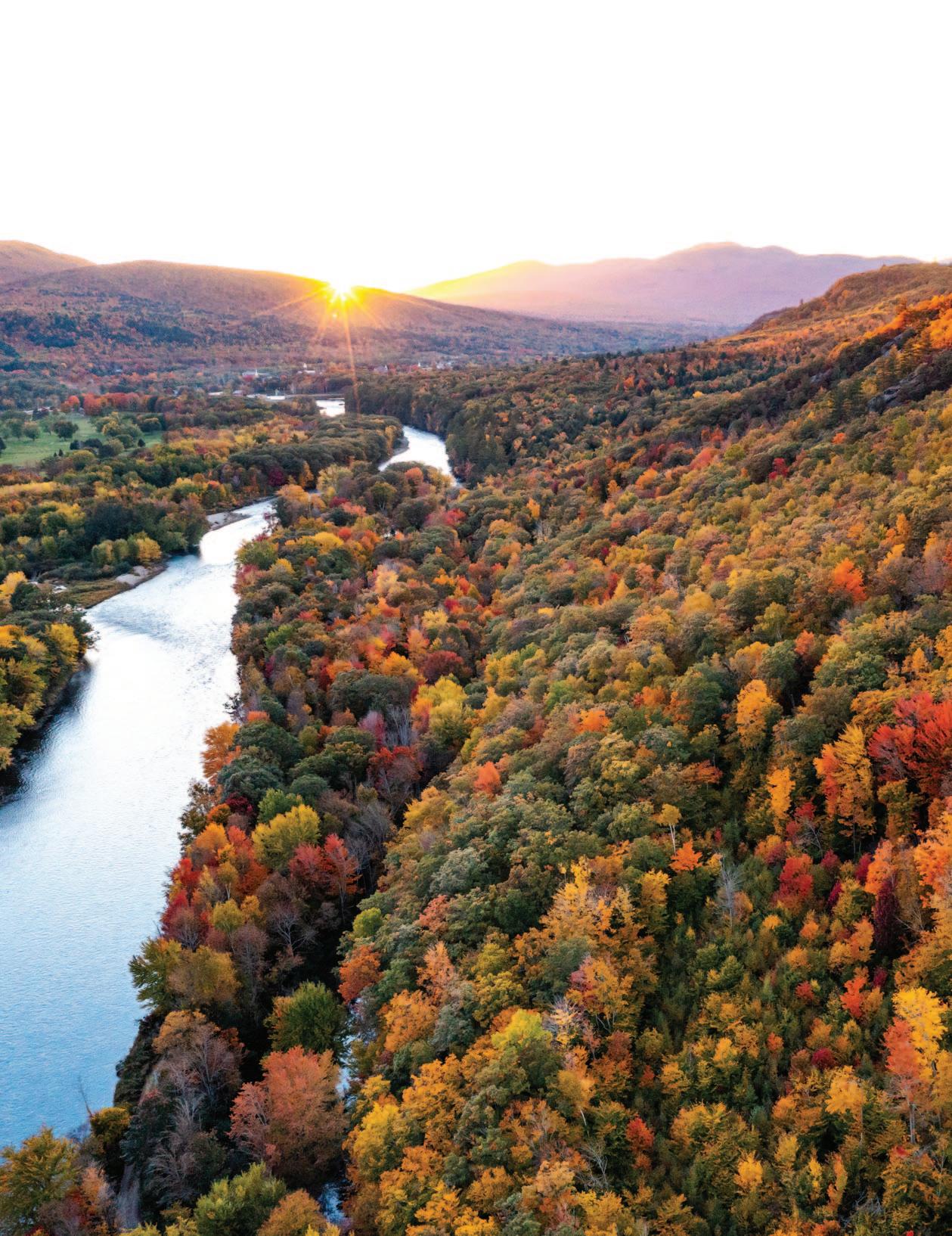




Protecting the Magnificent Mahoosucs forestsociety.org
2022 FAMILY FUN AT MORSE | AN ODE TO ASH
AUTUMN


Cut Your Own Christmas Tree Cut Your Own Or A Buy A Fresh-Cut Tree. Wreaths Available, Too! Enjoy horse-drawn carriage rides on weekends throughout the season OPEN DAILY NOVEMBER 25–DECEMBER 18 10 A.M.–4 P.M. THE ROCKS, BETHLEHEM VISIT FORESTSOCIETY.ORG/CHRISTMAS
On our cover: Rising from the banks of the Androscoggin River, the Mahoosuc Highlands property reaches to the rugged ridgeline of the Appalachian Trail in Shelburne, N.H. Working with partners, the Forest Society seeks to purchase 3,750 acres of forestland that includes 1.6 miles along the river and unique habitat for a wide range of species. Turn to page 6 to learn more. Photo:


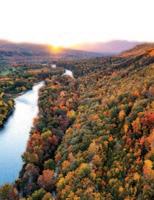



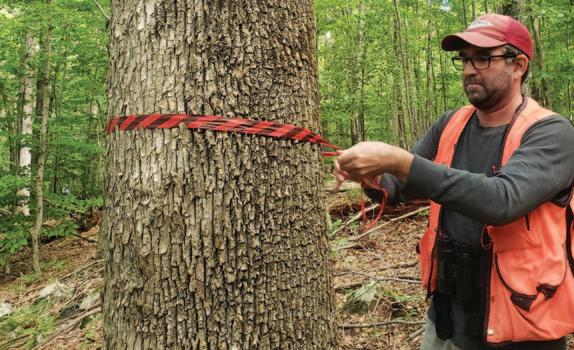

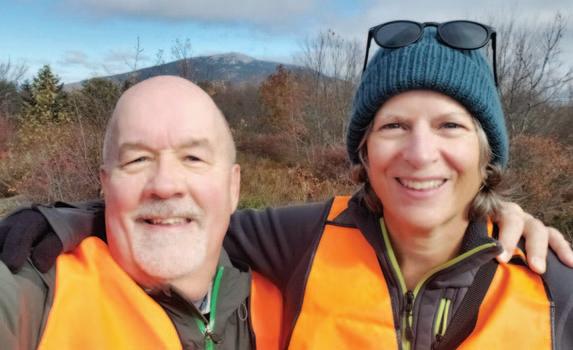
FEATURES 8 Finding More at the Morse Preser ve A family discovers more space, more smiles, and more blueberries a summit
a bustling
12 Connecting in Concord: The Forest Society ’s 121st Annual Meeting
Conservation
old
and time
DEPARTMENTS 2 FROM THE P R E S I D E N T’S D E S K Seeking solutions THE W OOD PILE + Conservation continues in the Lilac City + A new face at The Rocks + A big project makes progress 14 THE FOR E S T CL ASSROOM Planning for the future of ash trees 17 NATU R E’S VIEW Dying ash take leave of New Hampshire 20 ON O U R L AND A patch for every peak 22 PUBLIC P O LIC Y A new session on the horizon 24 P RO JECT I N P RO G R E SS Linking land in Allenstown 26 THE MANY FACE S OF CONS E R VATI ON A couple’s commitment to conservation 8 20 TABLE OF CONTENTS: AUTUMN 2022, N o. 311
away from
Mount Major.
An autumnal occurrence returns to the
Center, connecting new and
faces via walks, talks,
together.
(CLOCKWISE, FROM TOP LEFT)
14 Protecting the Magnificent Mahoosucs FAMILY FUN AT MORSE AN ODE TO ASH
JOHN WELCH, GABE ROXBY, RONALD BERUBE
Ryan Smith
CHAIR
Drew Kellner, Brookline
VICE CHAIR
Bill Crangle, Plymouth
SECRETARY
Karen Moran, Webster
TREASURER
Andrew Smith, Twin Mountain
PRESIDENT

Jack Savage, Middleton
BOARD OF TRUSTEES
Philip Bryce, Deering
Deb Buxton, Greenfield
George Epstein, Silver Lake
Elizabeth Salas Evans, Weare
Peter Fauver, North Conway
Don Floyd, Concord
Allyson Hicks, Concord
Jason Hicks, Meredith
Patricia Losik, Rye
Nancy Martland, Sugar Hill
Michael Morison, Peterborough
Bill “Tuck” Tucker, Goffstown
Tom Wagner, Campton
Janet Zeller, Concord
STAFF
Will Abbott, Project Manager, The Rocks
Frank Allen, Building and Grounds Assistant
Dave Anderson, Senior Director of Education
Anna Berry, Director of Communications and Digital Outreach
Nik Berube, Maintenance Assistant
Naomi Brattlof, Director of Easement Stewardship
Rita Carroll, Tree Farm Administrator
Tony Cheek, Vice President for Finance
Connie Colton, Land Protection and Stewardship Coordinator
Linda Dammann, Development Assistant
Carrie Deegan, Reservation Stewardship and Engagement Director
Alex Dow, Christmas Tree Farm Steward, The Rocks
Leah Hart, Land Conservation Project Manager
Stacie Hernandez, Land Conservation Project Manager
Laura Holske, Finance Specialist
Brian Hotz, Vice President for Land Conservation
Steve Junkin, Field Forester
Sarah Kern, Creek Farm Education Program Coordinator
Susanne Kibler-Hacker, Senior Philanthropy Advisor
Allan Krygeris, Senior Technology Specialist
Sara Krzyzaniak, Data Processor
Matt Leahy, Public Policy Director
Cameron Larnerd, Christmas Tree Farm Manager, The Rocks
Margaret Liszka, Membership Director
Nigel Manley, Senior Outreach Manager, The Rocks
Ann McCoy, Development Manager
Jack Minich, Regional Stewardship Manager
Michelle Morse, Human Resource Director
Brie Morshead, Regional Stewardship Manager
Carl Murphy, Facilities Manager
Meredith Reed O’Donnell, Foundation Relations Manager
Tina Ripley, Administrative Coordinator
Cara Pearson, Membership Specialist
John Plummer, Regional Stewardship Manager
Gabe Roxby, Field Forester
Jack Savage, President
Matt Scaccia, Recreation and Community Relations Manager
Ryan Smith, Communications Manager
Maria Stewart, Senior Executive Assistant
Anne Truslow, Vice President for Development
Wendy Weisiger, Managing Forester
Harriette Yazzie-Whitcomb, Administrative Assistant
Seeking Solutions
Given the popularity of ash trees in urban settings, we are getting front row seats to see the struggle that species is facing against the invasive emerald ash borer. As chronicled on page 14, stopgap measures may preserve the species until a solution is found, but in the meantime, we watch tree after tree succumb. It’s not a good feeling.
We might say the same of ourselves in the face of climate change—we are facing a seemingly overwhelming challenge that threatens our very perception of perpetuity. We don’t yet have all the solutions we need to allow us to thrive sustainably, and so we seek interim measures to carry us through.
At our Annual Meeting in September we heard from Dr. Michael Mann (see page 12), one of the foremost researchers and thinkers in our country on the challenges presented by climate change. Thanks to people like Dr. Mann, the public’s awareness and understanding of the damaging effects of climate change has increased. More of us now appreciate the urgency to do more—to act to counter those consequences.
It would be easy to point to the nearly 60,000 acres of forestland we own and manage, or the 135,000 acres of land under easement that are already sequestering and storing carbon and declare: the Forest Society is addressing climate change. Keeping forests as forests, encouraging sustainable management practices that provide renewable wood resources while enhancing carbon sequestration and storage, increasing resilience, and fostering
biodiversity are the wise use principles of our mission today.
As important as natural solutions are, we must also reduce our own emissions. To that end, we have been selected to work with the University of New Hampshire Sustainability Institute’s Carbon Clinic in the spring to assess our overall carbon footprint and target potential reductions, including our reliance on fossil fueled transportation. Our new Forest Society North campus at The Rocks in Bethlehem will aspire to be net zero, with a robust solar installation and geothermal heating. In Concord, it is our intention to expand substantially our existing solar array to reduce our reliance on the grid while lowering our energy costs.
I believe that from challenges come opportunities. In the face of climate change, more people than ever recognize the value of New Hampshire’s forests. More people than ever are embracing alternative energy sources and seeking to reduce emissions. Admittedly, like the Fraxinus americana (white ash), we don’t yet have all the answers. Unlike the ash, we humans have the ability—and the opportunity—to find those answers if we so choose.
Jack Savage is the president of the Society for the Protection of New Hampshire Forests. He can be reached by email at jsavage @forestsociety.org.

FROM THE PRESIDENT’S DESK
Workshop on Wheels
Partners host tractor class for women forestsociety.org/tractor workshop
Hot Off The Press

The Annual Report is ready for review forestsociety.org/annualreport22
Tree Farm Field Day
A colorful autumn tradition returns forestsociety.org/treefarm22

“My husband Bob is an animal enthusiast, so we like to flip over logs and rocks (always putting them back where we found them, of course) to check for salamanders and snakes. On the day we visited Moose Mountains Reservation, it seemed like there was a red-backed salamander under every log! Oliver, our furry hiking partner, loves exploring the woods. Shout out to the Forest Society for sending him his very own 5 Hikes Challenge buff!” – Abby Jones (@abbytomich80)
Tag #forestsociety on Instagram for a chance to be featured in a future issue of Forest Notes.
Society for the Protection of New Hampshire Forests

A nonprofit membership organization founded in 1901 to protect the state’s most important landscapes and promote wise use of its renewable natural resources. Basic annual membership fee is $40 and includes a subscription to Forest Notes.

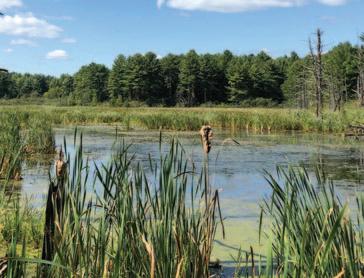

Editor: Ryan Smith

Design & Production: The Secret Agency Printing: R.C. Brayshaw & Company, Inc.

Forest Notes is printed on elemental chlorine-free Sappi Flo paper with 10 percent post-consumer recycled content. Sappi Flo is made from pulp purchased from suppliers who document sound environmental practices and sustainable forest management.
Permission is required for reproduction of any part of this magazine.
Copyright 2022 SPNHF. US ISSN: 0015 7457 54 Portsmouth Street, Concord, N.H. 03301 | Phone: 603-224-9945 | Fax: 603-228-0423 info@forestsociety.org | forestsociety.org
The Forest Society proudly supports the following organizations:


Cosponsor Member Underwriter WEB EXCLUSIVES
facebook.com/ForestSociety @ForestSociety @Forest_Society CONN ECT WITH U S!
(OPPOSITE PAGE)
PAGE,
Autumn 2022 FOREST NOTES | 3
RYAN SMITH; (THIS
CLOCKWISE FROM TOP LEFT) UNIVERSITY OF NEW HAMPSHIRE EXTENSION, BRIAN HOTZ, DAVE ANDERS ON, ABBY JONES (X2)
Conservation Continues in the Lilac City
In late August, the Forest Society purchased 122 acres of forestland and wetlands adjacent to its existing 185-acre William H. Champlin Jr. Forest in Rochester, with help from many supporters.

“We are so pleased that this acquisition will not only enhance the natural resources protected as part of the Champlin Forest, but also provide an even greater recreational asset in the heart of Rochester, a city of more than 31,000 residents,” Forest Society President Jack Savage says.
The land will be permanently conserved and open to the public thanks to combined contributions of $465,000 from numerous sources, including more than 250 individual donors from surrounding communities. In addition, the Adelard A. and Valeda Lea Roy Foundation awarded a grant of $7,500 and the Rochester Conservation Commission contributed $200,000. A $115,000 grant from the New Hampshire Land and Community Heritage Investment Program (LCHIP) and a $110,000 grant from the New Hampshire Department of Environmental Services Aquatic Resource
Mitigation Program were essential to this project.
“The expansion of the Champlin Forest helps preserve Rochester’s open space and further connects our community to the outdoors,” Rochester City Planner Ryan O’Connor says. “We’re thankful to the Forest Society, the Conservation Commission, individual donors, and all the partners that worked to make this happen. Opportunities like this help to balance growth and provide lasting benefits to the community and environment.”
4 | FOREST NOTES Autumn 2022 THE WOODPILE—NEWS NOT SO NEATLY STACKED
Old logging roads crisscross the new addition at the Champlin Forest in Rochester.
Consulting Foresters
The 185-acre William H. Champlin Jr. Forest was donated to the Forest Society in 2006 by Virginia Spaulding Champlin in honor of her late husband. At the time, the Champlins donated additional land to another local nonprofit, Homemakers Health Services, now a part of Easterseals of New Hampshire. It is 122 acres of this property that the Forest Society purchased and reunited with the 185-acre Champlin Forest, while Easterseals is developing affordable senior housing on the balance of their land.
“LCHIP is pleased to support the Forest Society’s Champlin Forest expansion, which will improve access to outdoor recreation close to home for residents of Rochester and Somersworth, two of New Hampshire’s largest communities,” LCHIP Executive Director Paula Bellemore says. “Completing the Champlin project has been very rewarding personally,” said Lori Sommer, wetlands mitigation coordinator
with the NH Department of Environmental Services, Water Division. “In 2005, I was involved in negotiations with the Champlin family and federal agencies concerning mitigation for the nearby Skyhaven Airport. That resulted in the breaching of two dams and conservation of 185 acres of the original William H. Champlin Jr. Forest. This 122-acre Forest Society addition significantly expands protection in a highly developed landscape, results in a connected habitat for wildlife, and furthers mitigation goals to protect the water quality of the Cocheco River watershed.”
The Champlin Forest already hosts a restored wetland and woodland trails are easily accessible from the main parking area off Route 108. The Forest Society plans to celebrate the expansion of the Champlin Forest with a winter walk to be scheduled later this year.
The Forest Society encourages landowners to consult with a licensed forester before undertaking land management activities. The following are paid advertisers.
Calhoun & Cor win Forestry, LLC
Realize what you value the most in your forest. Serving individual, municipal, state, non-government, and industry forest owners.
41 Pine St., Peterborough, NH 03458 • 603-562-5620
Email: swiftcorwin@gmail.com
FORECO: Forest Resource Consultants
Complete forest management services
Offering three licensed foresters, licensed land surveyor P.O. Box 597, Rumney, NH 03266 • 603-786-9544
P.O. Box 161, Contoocook, NH 03229 • 603-746-4846
Email: office@forecollc.com

Full Circle Forestry, LLC
Jeffrey Snitkin NHLPF #452 802-310-0292 • jsnitkin.fcf@gmail.com
Ehrhard Frost, NHLPF #103 802-785-4749 • efrost.fcf@gmail.com
Eric Radlof, NHLPF #447 603-321-8249 • eradlof.fcf@gmail.com
Providing a full range of ecologically based and economically practical forestry services to landowners that share a long-term stewardship vision for their forest.

-NRCS Technical Service Provider, Tree Farm Inspector 752 Rt. 103A Newbury, NH 03255 • 802-310-0292
Martin Forestry Consulting, LLC
Offering complete forest management services including timber sales, cruises, and appraisals and wildlife habitat management.
P.O. Box 89, New Hampton, NH 03256 • 603-744-9484 Email: martinforestry@gmail.com
Meadowsend Consulting Company
Quality Consulting Forestry with Integrity. Guaranteed. Jeremy Turner, NHLPF #318 — Southern NH jturner@meadowsendco.com
Matthias Nevins, NHLPF #518 — Central NH mnevins@meadowsendco.com
Ryan Kilborn, NHLPF #442 — Northern NH rkilborn@meadowsendco.com
Vast range of quality land management services. Connect with us for a free site consultation! meadowsendco.com • 603.526.8686
Licensed foresters should address inquiries about advertising to Anne Truslow by calling 603-224-9945 or emailing atruslow@forestsociety.org.
RYAN SMITH
Autumn 2022 FOREST NOTES | 5
Great gifts are just a CLICK away! NOVEMBER 2 - DECEMBER 5 nhpbs.org/auction Give a gift with impact. Shop our hassle-free auction and your gift is guaranteed to give back.
A Treasured Tree Farm Gets a New Tender
This fall, the Forest Society named Cameron Larnerd as its new Christmas Tree Farmer at Forest Society North at The Rocks in Bethlehem. In this role, Larnerd’s responsibilities will entail cultivating and growing 32,000 Christmas trees, managing the Forest Society’s tree retail and wholesale operations, and overseeing the farmhand staff and volunteers.

After previously collaborating with the organization as a Leave No Trace traveling trainer, Larnerd joined the Forest Society in early 2022 as the land steward and volunteer coordinator. “I truly enjoyed my role as a coordinator this past year, but my love for growing trees and desire to farm led me to pursue this new position,” Larnerd says. “I am looking forward to making the North Country my home, being a part of the community, caring for the tree farm, and welcoming all to the Forest Society North at The Rocks property.”
Growing up in New York, Larnerd developed a love of trees and nature and went on to earn a bachelor of science in natural resource management from The State University of New York College of Environmental Science and Forestry. He also attended Wanakena Forestry Ranger
School where he earned an associate of science degree in forest technology.
Centered around the scenic working tree farm and historic estate, Forest Society North at The Rocks serves as the Forest Society’s North Country hub for community engagement through recreation, educational programming, and tourism.
Since 1989, The Rocks Christmas Tree Farm has grown to be a popular destination and cutting a tree on the farm is an annual holiday tradition for many families.
After spending more than 35 years in the position, longtime Christmas Tree Farm Manager Nigel Manley is handing the pruning shears over to Larnerd. While Manley will no longer manage the tree farm, he continues to play an integral role at Forest Society North at The Rocks as the senior outreach manager, continuing to develop and run educational programs such as the very popular NH Maple Experience. Manley is also part of the capital campaign team working to raise $8.5 million for The Rocks’ renovation project that is in full swing.
Jack Savage, president of the Forest Society, added, “We are so fortunate that Cam brings to this new position a background and passion that will serve him well and that he will have the benefit of Nigel’s mentoring as he gets the lay of the land. It is an exciting time at The Rocks and having the tree farm in good hands is essential to our vision for Forest Society North.”
Mahoosuc Highlands Project in Shelburne Meets Milestones
As seen on the cover of this issue, the Mahoosuc Highlands encompass a spectacular landscape that stretches from the banks of the Androscoggin River to the flanks of Bald Cap Peak in the town of Shelburne, N.H.
Recent grant awards have brought the Forest Society ever closer to accomplishing this 3,750-acre acquisition. With grants from the NH Land and Community Heritage Investment Program, the U.S. Forest Service’s Community Forest Fund, and potential support from NHDOT wetland mitigation funds, we are well on our way to the $3.3 million project campaign goal.
Thanks to support from a private foundation, private contributions to the project will be matched 1–1 up to $250,000. To help us maximize this challenge grant and reach the full $500,000 fundraising goal, please visit forestsociety.org/mahoosucs.
This winter we will be working with members of the Shelburne community to form a Community Forest Advisory Committee, while we continue working with The Conservation Fund and the Mahoosucs Land Trust to complete the project. We hope to achieve our fundraising goal by early 2023 and keep on track to acquire these lands as the newest Forest Society reservation by the end of the 2023.
Thanks to all who have contributed so far!
6 | FOREST NOTES Autumn 2022 THE WOODPILE—NEWS NOT SO NEATLY STACKED
Christmas Tree Farm Manager Cameron Larnerd


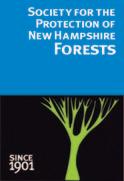






Autumn 2022 FOREST NOTES | 7 MONDAY- FRIDAY 8:30 AM TO 5 PM 54 PORTSMOUTH ST. CONCORD Now Open! Conservation Center Logo Shop Purchase hats, shirts, syrup and more! 10% membership discount NOW BOOKING 2023 & 2024 WEDDINGS The Rocks BETHLEHEM, NH forestsociety.org/weddings Little Harbor Happy Holidays Open House Saturday, December 3 1 p.m.–4 p.m. Enjoy hot cider and crafts with the Forest Society, GoodWork Seacoast, and Little Harbor Chapel during this holiday open house in Portsmouth.
Center Holiday ornament craft Crazy about conifers chat at 1 p.m. Photography exhibit and meet and greet with photographer Michael Sterling Refreshments Carey Cottage Open house Open music room Little Harbor Chapel Open house & holiday treats Free! RSVP at forestsociety.org/ holidayopenhouse Little Harbor Chapel Portsmouth, New Hampshire
Forest Society Education
RYAN SMITH
Finding More at the Morse Preserve
Photos and story by John Welch

Iadmit it. I overlooked the Morse Preserve in Alton for too long. The property’s 1,400-foot summit, Pine Mountain, seems to sit in the shadow of Mount Major, a more popular hiking destination that’s also owned and managed by the Forest Society. It wasn’t until I had nearly finished hiking all 69 miles of the Belknap Range’s official trails, including dozens of summits of Mount Major, that I first visited the Morse Preserve. On an unusually mild February evening in 2016, I set off for the summit from the trailhead on Avery Hill Road. When I reached the top, I lingered until sunset on a thawed patch of granite amid wild blueberry barrens and took in the views of the Belknap Range, White Mountains, and Lake Winnipesaukee. As I snapped photos of the landscape, I made a mental note to return to this place; there were possibilities here beyond a mere hike.
The author’s middle daughter, Gabby, and wife, Gloria, discover the joy of picking wild blueberries atop the Morse Preserve’s Pine Mountain.



Right:
Two months later I returned with my preschool-age daughter, Annabelle, on the first warm day of spring. Having been carried to summits before but never having hiked one under her own power, she was eager to start hiking them with Daddy. Our pace was slowed not by the trails, which were easy, but by her curiosity at every little thing she noticed along the way. She studied the forest floor and pointed out the red shoots emerging from the cracked acorns, part of the oak tree’s germination process. Wanting to emulate my hiking poles, she made one out of a stick she found. Wind and pride washed over her face as she took in the view from her first earned summit. I realized this was more than a hike—it was a foundational memory for us. The outing made such an impression upon her that she included the photo of us at the top as one of the five things on her life timeline assignment that she created upon entering kindergarten that fall. Both the photo and timeline remain on her bedroom wall to this day.

As the years passed, hiking Pine Mountain became a rite of passage for each of my two younger daughters. Knowing that my youngest daughter, Jenna, was more motivated by treats than views, my wife and I timed her first summit attempt around the peak of wild blueberry season in July. Jenna’s first taste of the smaller-yet-sweeter-than-grocery-store berries made her smile,
causing her stuffed cheeks to lift her pink eyeglasses visibly higher. My wife and daughters pretended to be bears foraging for the sweet morsels, and we spent an hour savoring the berries and views.

As we headed back down the trail, my middle daughter, Gabby, noticed wood lilies in bloom. “Are these tiger lilies?” she asked. I explained that they were a native wild look-alike of her favorite flower. We love to go birding as a family and were excited to hear an unfamiliar metallic trilling bird song coming from the scrub oak thicket below the summit. We tracked it down and found it was made by an eastern towhee, a new species the girls had not seen or heard. This discovery, along with a growing passion for wildlife photography, prompted me to see even more potential for future trips to the Morse Preserve.
The next spring, I came back with my 600 millimeter lens early one morning to photograph birds. My main goal was to find ruffed grouse among the ideal shrubby habitat along the Mary Jane Morse Greenwood Trail. It didn’t take long for me to hear the supersonic whomp-whomp-whomp sound of male grouse drumming their wings on logs as part of their courtship ritual. This was the behavior I was hoping to photograph. I searched the thickets to try to find a drumming log covered in grouse scat. Instead I found rabbit droppings, coyote scat, and the scattered
10 | FOREST NOTES Autumn 2022
Left: The author’s family poses atop Pine Mountain.
In 2016, the author’s oldest daughter, Annabelle, hiked the Robert A. Greenwood Sr. Loop Trail on her way to summiting Pine Mountain for the first time.
feathers of a dead grouse, which was likely the victim of the same coyote. Though I didn’t get the grouse photos I was after, I did get some beautiful photos of the returning eastern towhees and migrating warblers on newly budded out branches. This outing gave me an appreciation for the rich habitat that the Morse Preserve provides for a diverse array of species.
The preserve is a place for a diverse array of people, too. When I returned to the summit after looking for grouse that morning, I saw a small group getting ready to celebrate a wedding. The young bride and groom had donned jackets over their wedding attire to brave the chilly wind gusts, but they still seemed radiant in this place. I also know of a serious birder who uses the summit to observe raptor migration in the fall. Families often visit the summit as a sunset picnic spot. It is no surprise that people are discovering the Morse Preserve given that it is an easy drive from many of New Hampshire’s main population centers such as Concord, Manchester, Laconia, Dover, and Rochester.
This public access has been enabled by the Forest Society’s stewardship and conservation efforts. Formerly private land where generations of the Morse family lived for 135 years, the preserve was created in 2008 thanks to a 431-acre gift from Mary Jane Morse Greenwood. She named the trails in memory of her predeceased family members. Recently, the preserve was
expanded by a Forest Society acquisition of a 222-acre parcel on the southern ridge of Pine Mountain and a 260-acre conservation easement connecting the existing northern portion of the preserve through a beaver pond and wetland complex to Jesus Valley Road. Thanks to these efforts, this land will remain a place to make more memories and discoveries about the natural world in the future.
This fall, my kids have asked about winter hiking and learning about what to wear, what to pack, and what tasty treats we can eat along the trail. A family outing to teach them might be our next memory made at the Morse Preserve. I can’t wait to return

John Welch is an educator and photographer who resides with his wife and three children in central New Hampshire. To see more of his work, visit jwelchphoto.com.
Online
Learn more about the recent additions to the Morse Preserve by visiting forestsociety.org/morseadditions.
Autumn 2022 FOREST NOTES | 11
The author and Annabelle atop Pine Mountain on her first mountain hike. This photo remains on her bedroom wall to this day.
Above: Dr. Michael E. Mann, distinguished scholar of climate science and author of The New Climate War, encouraged Annual Meeting attendees that it's not too late to take action on climate change.

Left: Annual Meeting attendees enjoyed a refreshed Conservation Center, including a pollinator garden near the front door.

Connecting in Concord: The Forest Society’s 121st Annual Meeting
The Forest Society welcomed nearly 150 members and friends to its statewide headquarters in Concord on September 24 for its 121st Annual Meeting. Attendees gathered to celebrate the Forest Society’s accomplishments over the last year and to learn more from keynote speaker Dr. Michael E. Mann about how to take bold action to avert the worst impacts of climate change.
Dr. Mann, distinguished scholar of climate science and author of The New Climate War, among other books, is a presidential distinguished professor in the department of earth and environmental science at the University of Pennsylvania, with a secondary appointment in the Annenberg School for Communication. “It’s not too late,” said Dr. Mann in his Annual Meeting speech. “Ironically, the belief that it’s too late could be the one thing that makes it too late. The impacts of climate change are no longer subtle. Denial just isn’t credible.”
President Jack Savage shared the Forest Society’s plans to reduce the organization’s emissions and advocate for policies that will address climate change locally and nationally, but he acknowledged, “It would be easy to highlight our own plans to
reduce the Forest Society’s emissions or to point to the nearly 60,000 acres of forestland we own and manage, or the 135,000 acres of land under easement that are already sequestering and storing carbon, and declare: the Forest Society is addressing climate change. After all, New Hampshire arguably invented additionality as our forests recovered substantially from 1850 to 2000, sequestering carbon annually—we’ve done a lot.”
Savage noted that resting on the Forest Society’s work and history is not sufficient. “If everyone in this state or country feels they have already done enough to mitigate the consequences of climate change, this crisis will not be resolved,” he says. “So, even though we are just one organization that operates in one of the smaller states in the country, we must commit to act beyond the walls of the Conservation Center and outside the boundaries of our forest reservations.”
During the business portion of the meeting, Phillip Bryce of Deering was elected as a new member to the Board of Trustees. Bryce previously served on the board in 2010 and 2011 before stepping away to become director of New Hampshire State Parks.
12 | FOREST NOTES Autumn 2022
Photos and story by Anna Berry
Award Winners
Karen Moran, of Webster, was elected by members to continue to serve as secretary of the board.
Board members met following the meeting to elect two new officers: Drew Kellner of Brookline as chair and William Crangle of Plymouth as vice chair. Andrew Smith of Twin Mountain will continue serving as treasurer.
Also at the meeting, the Forest Society presented the Conservationist of the Year Award to Lorin Rydstrom. This prestigious award honors people whose work to promote and achieve conservation is exemplary and whose actions have advanced the protection and stewardship of land statewide. Hailing from Hollis, Rydstrom was honored in recognition of his longtime career as a founder of Seaboard International Forest Products, his personal dedication to conserving New Hampshire’s working forests and special places, and his leadership in supporting conservation work across the state. “Lorin understands a day in the woods, whether hunting, fishing, working, or just walking, is a day well spent,” said Drew Kellner, incoming chair of the Board of Trustees. Rydstrom has been a member of the Forest Society since 1994 and served on the Board of Trustees from 2013 to 2021. “Lorin’s impact on the Forest Society and as a leader will be felt for generations to come,” Savage says.
The Trish Churchill Volunteer of the Year Award was given to Dave Heuss. This annual award honors exemplary people who have volunteered their time, resources, and energy to help the Forest Society achieve its mission. Based in Concord, Heuss has

volunteered with the Forest Society for the past eight years. He first volunteered to be a land steward for Woodman Forest in Boscawen, but his volunteerism has expanded tenfold since.


Heuss has helped lead guided hikes for the popular Forest Society 5 Hikes in 5 Weeks program, built rock stairs during Monadnock Trails Week, tends to the Tom Rush Forest chestnut seed orchard, participates in the sugar maple regeneration citizen science program, and has staffed numerous Forest Society events and programs over the years. Heuss is also a master woodworker and has built kiosks and bridges, fixed doors, and done numerous odd carpentry jobs around the Forest Society Conservation Center. “It’s hard to think of a volunteer workday, event, or program that Dave has not been involved in over the past eight years,” President Jack Savage says. “From tending our chestnut seed orchard to making two hundred perfect little tree cookies to hand out to kids during an education program to flipping flapjacks for the governor and Executive Council, he is willing to do anything and has the skills to do everything. Dave has become an indispensable colleague and a good friend to many of us here at the Forest Society.”
Learn More
The Forest Society presented its 121st Annual Report at the Annual Meeting. Read all about our accomplishments over the last year by visiting forestsociety.org/annualreport.
Autumn 2022 FOREST NOTES | 13
Anna Berry is the director of communications and digital outreach.
Left: Shirley French (right) poses with her son, Jameson S. French, after being recognized at the Annual Meeting for her 65 years of membership. Middle: From left, Lorin Rydstrom, 2022 Conservationist of the Year, with President Jack Savage and incoming Board of Trustees Chair Drew Kellner. Right: Volunteer of the Year Dave Heuss (right) and Forest Society Reservation Stewardship & Engagement Director Carrie Deegan.
Foresters Take an Active Approach to Protecting Ash
By Gabe Roxby
In mid-September, Forest Society Forester Steve Junkin, Senior Technology Specialist Allan Krygeris, Cheshire County Forester Matt Kelly, volunteer Sarah Thorne, and I armed ourselves with binoculars and flagging tape to search for and tag female ash trees. Walking in a line, we scanned the lower flanks of Monadnock Reservation, one of the Forest Society’s most spectacular stands of white ash. This stand
has yet to be impacted by the emerald ash borer, an invasive insect which will likely arrive here in the next few years. The search was slow going; our necks were starting to hurt, and I hadn’t found a single female ash tree yet! Morale was dipping.
To understand what prompted this initially fruitless search for female ash trees, we need to understand more about the plight of ash in our forests. The emerald ash borer

(EAB) is an invasive forest pest that has been decimating native ash tree populations across North America since it was first detected in Michigan in 2002. The first sighting in New Hampshire was in 2013, and since then, this invasive insect has spread rapidly to nine of the state’s ten counties. At the moment, there is little chance of preventing the near-complete loss of all of the mature ash trees in our forests.

14 | FOREST NOTES Autumn 2022 THE FOREST CLASSROOM
Above: Looking up into the canopy of an ash-dominated northern hardwood forest. Inset: The author holds a cluster of ash seeds.
Left: A map from the most recent forest inventory allowed the group to pinpoint the parts of the forest that had the heaviest concentration of ash.

Right: Look closely! Can you spot three people in this photo searching for female ash trees?
Currently, the best hope to retain ash on our landscape is through the introduction and establishment of biocontrol insects. The hope is that the introduced insects, which parasitize EAB eggs and larvae, will control borer populations so that they can co-exist with ash, similar to the way many of our native borer beetles behave. However, EAB has a head start, and the biocontrol insects do not have much of a chance of stopping the initial killing wave of EAB before most of our large ash trees are wiped out.
This all sounds bleak, but there is a glimmer of hope. EAB does not seem to kill seedling and sapling ash trees, which provides an opportunity for foresters to manage ash stands in a way that may help retain ash on our landscape. The thinking is that if we can establish young ash trees in the understory of our forests, they will be able to survive the initial wave of EAB.
Solemly
White Ash Lament
By Sarah Thorne
Your roots, your trunk, your branches
We bushwack into the waiting forest. Forming a line five abreast, A search party for White Ash.
We are in pursuit
Of healthy females in the canopy. Arrow-like seeds on the ground Call us to attention.
Spinning beneath towering trunks, We look for portals to their crowns. Up, up above the lesser trees, Ash proclaim dominion.
Why do males outnumber females 7:1?
We contemplate the secrets of ash, Gazing through our binoculars, Peering into realms of dioecious exchange.
We lie on the ground
To save our necks, Steady our hands, And commune with the majesty. The trees are oblivious, Flinging their boughs to the sky Festooned with tinges of autumn.
Is this one a female? There, caught in the sunlight, Glittering like crystals, Seeds have already begun flying.
Grew as bulwarks for a century of seeds, Alighting in their coveted spots In the community of Monadnock.

But global trade and human hubris Intervened Invaded Eliminated.
Now, what can we offer? Inoculation for a small refugia Of the Monadnock gene pool, Precious seeds full of hope?
A regeneration harvest To jumpstart a new generation? A parasite for the borer That won’t out-bore us?
Will this be your last season of glory? Will this be the last autumn you Scatter your gems across the forest?
I lay transfixed by dancing branches Wanting to remain forever
In dappled sunshine Beneath the living matriarchs. Beseeching them to survive.
Autumn 2022 FOREST NOTES | 15
(OPPOSITE PAGE, FROM LEFT) SARAH THORNE, GABE ROXBY; (THIS PAGE, FROM LEFT) GABE ROXBY, STEVE JUNKIN
CLASSROOM
As these young ash trees grow, it is possible the biocontrol insects that are being released now will have time to become better established and may afford some protection as the ash trees grow larger. Additionally, if there is some genetic resistance to EAB in some ash trees, stands with thousands of small ash are more likely to contain a tree sapling with this resistance than a stand with only a dozen large ash trees. More ash trees per acre gives us a greater chance that one of those trees might contain something important in its genetics that could help us retain ash in our forests.
In the next few years, the Forest Society is planning to implement a timber harvest on one of our best ash stands on Mount Monadnock with the goal of regenerating a blanket of white ash seedlings. Since a single ash tree is either a male or a female (in some tree species this isn’t the case and a tree may have both male and female parts), it will be important to make sure we leave some of each uncut during the harvest to provide the species an opportunity to pollinate and set viable seed.
Females aren’t as common as males, and some estimates put the ratio at only one female tree for every seven male trees. During the harvest, foresters want to make sure they leave enough female trees so they can provide an opportunity for ash to regenerate.
But how do you tell if an ash tree is male or female? It can be difficult to tell because female ash trees only produce large amounts of seeds every three to five years on average. Fall 2022 has been an excellent seed year for white ash across the region, hence our ash seed recon at Monadnock Reservation.
Our initial strategy was to walk in a line looking at the crowns of each ash tree for seeds. This method was brutally slow as it was difficult to see the seeds in the crowns of these impressively tall trees, especially with the leaves of nearby trees obscuring our view.
After about an hour, we settled on a much better strategy: around each ash tree we found, we surveyed the base of the tree
for seeds. If seeds were spotted, we lay down on our backs and searched that tree for seeds in the canopy. It turns out, at this time of the year at least, many of the ash seeds didn’t fall far from the tree, and so this method allowed us to refine our search. We lucked out on this field day, as we found ash seeds both on the ground and in some trees. Searching for female ash trees in late fall can also be fruitful, as the trees hold onto their seeds and seed stalks long after all the hardwood trees have dropped their leaves. Scanning tree crowns can be much more efficient during these months than when trees still have leaves.
Now knowing where the female ash trees are in this stand, we can make better
choices on which trees to leave uncut during the harvest. We still have more to figure out on the timing of the harvest, and the pattern and density of the trees we will leave uncut, but this felt like a good first step.
Gabe Roxby is a forester for the Forest Society.
Learn More
Learn more about the emerald ash borer and report sitings of the species to UNH Extension at nhbugs.org.
If you’re interested in conducting similar management aimed at retaining ash on your land, please contact Gabe Roxby at groxby@forestsociety.org.

16 | FOREST NOTES Autumn 2022
THE FOREST
Cheshire County Extension Forester Matt Kelly flags a female ash tree on the flanks of Mount Monadnock.
Dying Ash Take Leave Of New Hampshire
Photos and story by Dave Anderson
We knew it was coming…now it’s here. Only now are more people, from homeowners to forestry professionals, seeing white ash trees die from Emerald Ash Borer (EAB). Ash are standing dead on front lawns, along backyard stonewalls, and beside roads. Their death feels sudden but it’s likely that the early signs of the infestation were present two years ago. Now ash are conspicuously dying as the EAB infestation spreads in every direction from Concord, N.H., where the borer was first detected almost a decade ago in 2013.
Ash trees make up 3–10 percent of New Hampshire by forest area extent. This percentage varies with local soils. People and ash trees tend to occupy the same landscapes: low- to mid-elevation hillsides and moist, rich soil where forests reclaimed former farmlands. Ash trees are equally familiar as a landscape shade tree or a forest tree, but their final act seems poised to best benefit woodpeckers and the business of arborists using cranes, bucket trucks, chainsaws, and chippers to remove them from tight quarters around homes, roads, and power lines.
Sunapee-based New Hampshire arborist Tyler Webb of Harding Hill Forest Management provides tree care, including pruning, removal, and cabling. Business has been booming in response to the cresting wave of ash tree infestation. “People seem surprised at how quick it’s all happening, but people in the industry knew this was coming,” he says. “The unfortunate aspect of tree removal can be the emotional side of removing feature trees.”
For example, Webb responded to a homeowner’s concern for pruning a single ash tree. After assessing the tree and others growing nearby, Webb had to tell the homeowner the bad news that several
more ash trees would need to be removed due to their proximity to structures and wires in their fall zone. Neighborhood trees that exhibit health issues and structural defects are at risk of falling on something and need to be removed, Webb says.
He cites a decade of general ash tree decline. ‘Ash yellows’ is a fungal disease that had been affecting white ash growing at the edges of woodlands, lawns, and fields. Now EAB is the dominant cause of ash mortality. Only in the past five years have local arborists asked the question, “Which is it?”

Autumn 2022 FOREST NOTES | 17
(OPPOSITE PAGE) GABE ROXBY
The bark of the majestic ash tree.
NATURE’S VIEW
Webb adds, “many forest landowners have forest management plans for woodlots, but smaller landowners and homeowners don’t have a plan…particularly in lakeside communities with seasonal second homes. Homeowners had no idea extensive removals would be required and the unanticipated expense comes with a sticker shock.” Having worked in the Hartford, Conn., suburbs made up of 1970s era homes, Webb describes “landscape maturity,” where
50 years later, trees have outgrown their sites and, he says, “it’s time to re-set some residential neighborhoods.” As ash trees die in heavily forested areas, resulting standing dead snags and fallen rotting logs will continue to provide wildlife habitat benefits.
A “Quirky ” Species
White ash grows best on moist, semienriched sites along seasonal brooks and
An ash tree in front of the author’s house slowly succumbs to the infestation of the emerald ash borer.
stonewalls or at the toe slope of steeper ground where nutrient-rich soil accumulates and groundwater seeps provide ample moisture. White ash often cooccurs with sugar maple and basswood.
Longtime Merrimack County Forester Tim Fleury says, “Ash is quirky. They are typically the last trees to leaf out; sometimes as late as the first week of June. They are also the first to drop leaflets in the fall. I have seen white ash drop all its leaflets in a single day; it was like a snow shower!”
Fleury describes how ash tops break apart quickly after dying but how living trees can rebuild their canopy quickly if still alive. “Remember how all the ash looked like sharpened pencils after the Ice Storm of January ‘98?” he notes. “But also remember that they rebuilt themselves.”
Fleury talks with many landowners about the future of ash. “Almost everyone I talk to has heard of EAB. The awareness was there. However, since it can take
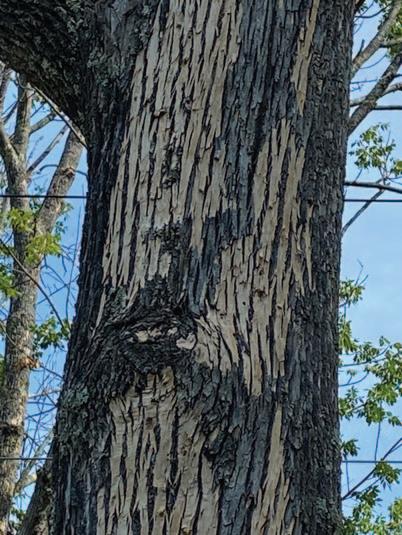
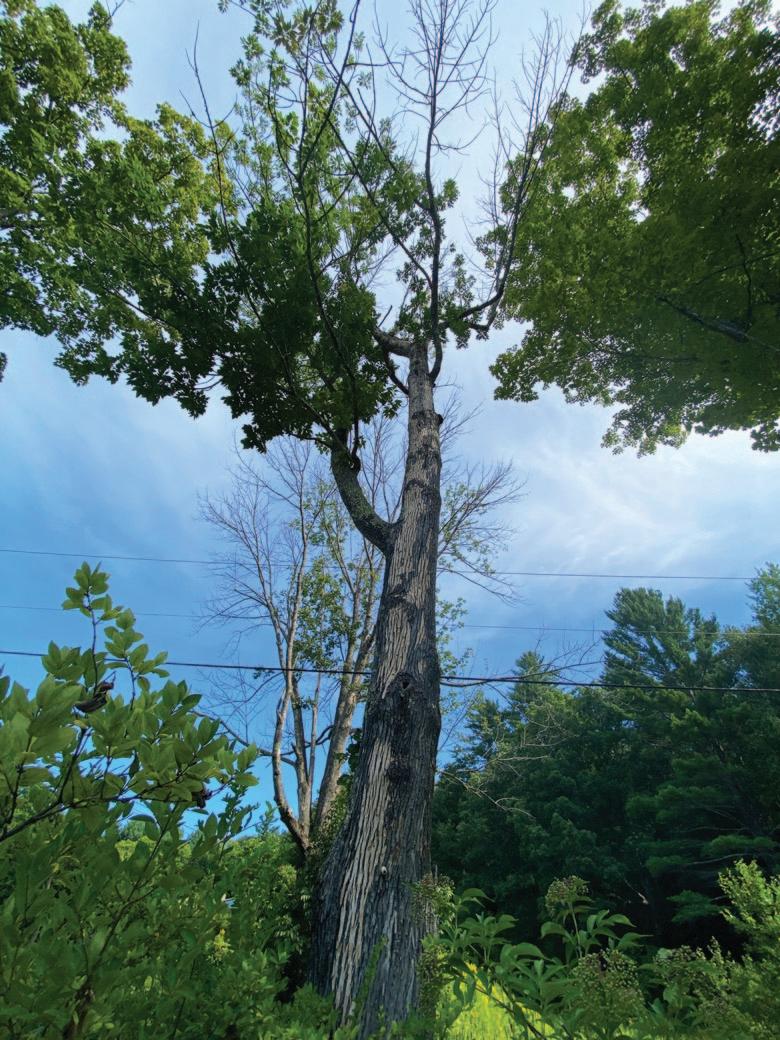
18 | FOREST NOTES Autumn 2022 NATURE’S VIEW
several years before trees get infested and show symptoms, it seems sudden. Nobody paid any attention until their ash tree died. Then we get the calls about what to do about it.
“Depending upon how attached a homeowner is to a tree, [the loss] can be like experiencing the five stages of grief. I understand that but I am also the voice of reality. If they don’t treat their tree, it will in all probability die and eventually fall over. Gravity always wins.”
Hope For the Future?
Forest Society forester Steve Junkin agrees with Fleury’s sentiment. “I told one new neighbor that if he doesn’t do something now he will lose his front yard ash tree.” I asked if he received an emotional response. Junkin replied, “Well, first you need to care enough to seek out good information to even have a response. He
had no idea about EAB. He was interested to hear that you can save ash trees by injecting pesticide and was interested because he really likes that tree.”
In my conversation with Junkin I asked him if it’s inevitable that all ash trees will eventually die. “No, that’s not the latest thinking!” he remarks. “Their numbers will shrink but white ash stands the best chance because of showing better resistance abilities versus black or green ash.”
Professor Tony D’Amato at University of Vermont is spearheading a communication effort to save white ash, and he says that we should not think of them as 100 percent doomed. Junkin says that some biological controls show promise. “If we can rebuild populations of ash after the main wave of EAB has gone through and introduce biocontrols, that may keep EAB in check,” he notes. “When today’s seedlings and saplings become vulnerable,
the wave will have passed and biocontrols will be established.”
Tim Fleury reflects, “I've now gotten used to seeing dying ash in Merrimack County. Yet, when I stop to think about it, I lament the passing of a beautiful and quirky species. It is a loss to the forest and to our society. I’m hopeful that biological controls will kick in and ash trees may rebound in 20 or 30 years. Who knows, maybe some of us will live long enough to see it?”
Dave Anderson is the senior director of education for the Forest Society.
Learn More Turn to page 14 to read how the Forest Society is taking measures to protect and rebuild ash tree populations at Monadnock Reservation.
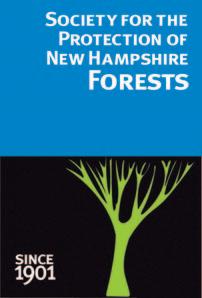
YOUR GUIDE TO FOREST SOCIETY TRAILS!

The Forest Society Mobile App, powered by OuterSpatial, makes getting outside easy by putting information about amazing destinations –including directions, photos & maps – right at your fingertips.
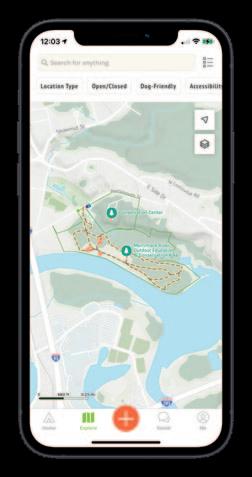
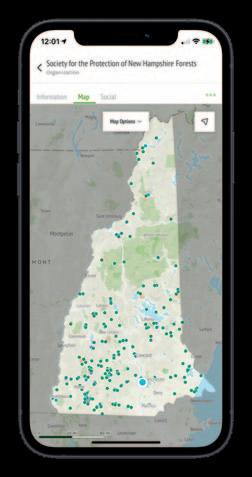

Autumn 2022 FOREST NOTES | 19
Aim your smartphone's
at the QR
to download the OuterSpatial app & join our NH
Learn more:
camera
code
community.
forestsociety.org/app
A Patch for Every Peak: Hiking Challenges Are All the Rage
By Sophie Oehler
When I entered freshman year of high school, my parents decided our family should hike all 48 of New Hampshire’s 4,000-foot mountains by the time I graduated. It would’ve been a great activity if my
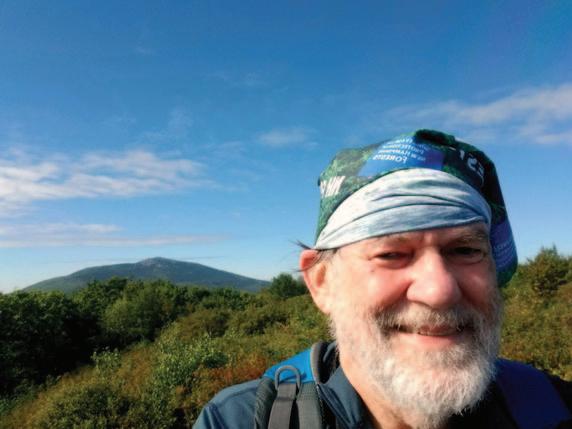


brother and I didn’t have year-round sports commitments and a large indifference toward the idea of accomplishing such a feat. Needless to say, we didn’t make it that far.
Since then, I’ve grown to love hiking,
becoming more knowledgeable about the trails and mountains that so many have embraced before me. My interest also led me to examine more closely a longtime, but ever expanding, interest among hikers: hiking challenges. You’ve heard of New
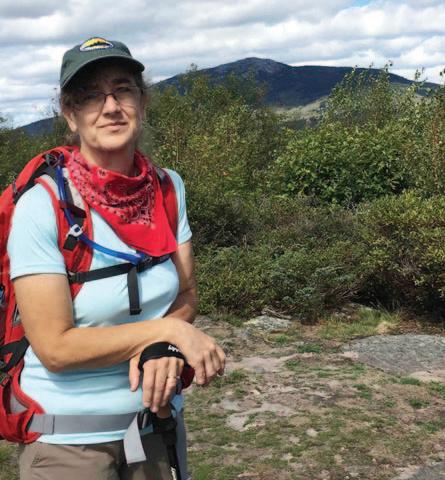
20 | FOREST NOTES Autumn 2022
ON OUR LAND
1 3 4 2
1. Sporting a 5 Hikes Challenge neck gaiter, Carsten Turner takes a selfie on South Twin Mountain. 2. Andrew Najberg completed the 2022 5 Hikes Challenge in less than two weeks thanks to beautiful September weather. 3. Ronald Berube and Joanne Davis pose at the top of Gap Mountain in 2021. 4. Tammy Ditman co-founded the Peaks and Perks NH Patch Challenge after taking part in the 5 Hikes Challenge.
Hampshire’s 4,000-footer list and perhaps 52 With A View. But were you aware of the firetower list? How about Views and Brews or The Terrifying 25?
I spoke to a few hiking challenge enthusiasts who shared some wisdom and inspiration that will have you itching to join the fun and earn a patch or two in return.
Turned on to Hik ing
Carston Turner was raised to want to get up and go. “There was sort of this sensibility of doing things and not just sitting idly by,” Turner explains. These values, instilled in him early in life, have led him to become one of the most accomplished hikers I’ve met. Turner, of Milford, N.H., has hiked New England’s 100 highest peaks, including all 67 of the 4,000 footers in New England.
“I used to say, ‘I’ll never be able to do [it],’ but at a certain point, I thought I better stop saying that because I’m just proving myself wrong,” he remarks. His adventures have also given him a new way of looking at hiking. He’s come to realize that when something feels difficult it probably is difficult. Turner says we remember the mountains because they are sometimes not fun. “When you hike Mount Washington and stand on the summit knowing you got there under your own power, you’re able to say ‘I did it,’” Turner notes. “Once you can say that, no one can take that away from you.”
Turner also recently took part in the Forest Society’s 5 Hikes Challenge where participants select five hikes from more than 25 Forest Society reservations and complete them at their own pace in a twomonth window of time. Past participants Roland Berube and Joanne Davis say the challenge, now in its third year, inspires them to explore new parts of the state. Berube and Davis are long-time outdoor enthusiasts. Berube grew up in Manchester, N.H., and spent much of his childhood hiking, biking, kayaking, and skiing.
Davis, on the other hand, grew up in the suburbs of Chicago. Moving to New Hampshire brought her new opportunities to spend time outdoors, whether it be going for a paddle on a river or working in her garden. For the couple, the pandemic only increased their love of the outdoors. “During COVID, we realized we like being outdoors after having been pushed indoors. The [5 Hikes] Challenge gives us a way of finding new areas to be outside.”
Andy Najberg, another 5 Hikes participant, had a different approach to the outdoors over the last two years. “I didn’t do much hiking during COVID because I figured that’s where a lot of people were heading, since it was something to do where you could be alone,” he said. Najberg is an avid hiker and completed the New Hampshire 4,000 footers list in college. Living in New Hampshire for the past 47 years, he has also developed a passion for wildlife photography. While visiting the Heald Tract in Wilton during the 2021 5 Hikes Challenge, he found fresh inspiration when he stumbled upon a family of otters playing in the pond. “I ended up spending a half hour photographing them and having a snack,” Najberg said. “When you find something like that, it’s really cool.”
A Fine Grind of Hikers
Sometimes, participating in a hiking challenge isn’t enough. Tammy Ditman and Linda LaFlamme blazed their own path by creating their own. Their hiking challenge—called Peaks and Perks NH Patch Challenge—was born of their mutual love for hiking and coffee. The ladies have been hiking together for years after both of their hiking partners decreased their activity due to injury and illness.
“Our idea [for this challenge] was twofold: to get people to support some independent businesses in New Hampshire and to get people out exploring the state beyond the White Mountains,” LaFlamme says. The White Mountains are a hiker’s paradise, but due to their size, difficulty, and complexity, they aren’t for everyone. As LaFlamme explains, “A peak doesn’t have to be the top of a mountain. If your peak is sitting on a big boulder, awesome...Your peak could even just be having a moment with your friends or family.”
Ditman and LaFlamme had casually tossed the idea of making their own hiking challenge for months, though it did not get very far. Then one day, Ditman drafted a rough sketch of what their hypothetical patch might look like, and soon after LaFlamme had a short list of possible hikes and coffee roasters. From there it was off to the races. The rules of the challenge are simple: hike at least a mile in each region of the state and then, within 48 hours of completing your excursion, purchase a bag of coffee beans from a roaster that is local to that area. On their Facebook group page, participants can find an ever-growing list of coffee roasters to choose from. As for picking what trail to hike, the ladies say you’re on your own. “You have to do some research!” Ditman exclaims. “By having folks study maps, it really gets people to learn more about the state.”
While the point of a hiking challenge is certainly to set your sights on something that will test your abilities, LaFlamme points out that you should challenge yourself wisely: “It’s good to push your limits, but it’s also important to know them.”
Sophie Oehler was the 2022 summer communications intern at the Forest Society.
Learn More
+ Learn more about the 5 Hikes Challenge at forestsociety.org/5hikes.
+ Learn more about the Peaks and Perks Challenge at facebook.com/PeaksandPerksNH.
Autumn 2022 FOREST NOTES | 21 COURTESY PHOTOS
PUBLIC POLICY
A New Session on the Horizon
By Matt Leahy
If you have ever been to the New Hampshire State House or the Legislative Office Building across the street when the Legislature is meeting, you know how full the hearing rooms become as people wait to testify on a particular bill or how crowded the hallways are as legislators, lobbyists, and the public discuss the issues of the day. Sometimes you may wonder how the elected officials work through all the legislation in front of them. Yet, somehow, they accomplish this task.
The 2023 Legislative Session looks to be another busy one. Lawmakers convene on January 4, 2023, for the start of their 168th session. As is the case with every session, they face a heavy workload of bills. In 2023, they will need to work through over 900 bills and, unlike in the U.S. Congress, each one of those bills must receive a committee hearing and a vote before the New Hampshire House of Representatives, the NH Senate, or perhaps both bodies. To add to their responsibilities, they will also need to approve the next state budget for fiscal years 2024 and 2025.
Of course, the Forest Society will not take positions on every one of these bills. Instead, we will need to determine which ones demand our attention. We do that by following two overarching benchmarks to determine our position on legislative proposals. First, we filter any decision through the guiding words of our mission “to perpetuate the forests of New Hampshire through their wise use and their complete reservation in places of special scenic beauty.” If the passage of a bill would undermine our ability to carry out that mission, we simply cannot support it. Second, we also consider the effects a bill could have on the broader conservation values which we believe should continue to steer New Hampshire’s commitment to its natural resources.
For example, one bill proposes to eliminate one of the dedicated fees that support the Land and Community Heritage Investment Program (LCHIP) thereby drastically reducing the funding available to the program. Another one would significantly revamp the New Hampshire Site Evaluation Committee, the regulatory body charged with deciding whether to permit the operation of largescale energy facilities.
While those two are concerning to us, the Legislature will discuss others that aim to protect New Hampshire’s natural resources. For example, legislators will consider a re-introduced version of HB 1454, a bill the legislature considered in the 2022 session that aims to put in place new requirements for the siting of a solid waste landfill near a body of water.
But there are others that will be of interest to the stakeholders and advocates for environmental protection, conservation, and climate change in New Hampshire. Here is breakdown of the categories related to those issues we believe will be hot topics in the Legislature in 2023:
NEW HAMPSHIRE SITE EVALUATION COMMITTEE: Given the heavy focus in recent months on the cost of energy, expect to see at least one bill that would revamp the NH SEC.
BIOMASS: The debate over whether the State should provide financial support to the biomass power plants has become a perennial one. This year will be no different as the Legislature is likely to argue the issue again.
CLIMATE CHANGE: Unlike other states, New Hampshire has not set in statute carbon emission reduction and clean energy goals. For example, Vermont has a plan in place that aims to set a pathway for the state to obtain 90 percent of its energy from renewable sources by 2050. The New Hampshire Legislature will likely consider a proposal to set a similar goal for our state.
LAND CONSERVATION: The previously noted bill to undercut the funding stream for LCHIP will be the major one the conservation community will need to engage on.
WATER RESOURCES: The threat that perfluorinated chemicals pose to the state’s water resources will continue to be a priority for the Legislature as they will be considering several bills that focus on this issue. In addition, lawmakers will take up a bill that would establish the cyanobacteria mitigation loan fund.
SOLID WASTE: As noted, the Legislature will consider a re-introduced version of House Bill 1454 from the 2022 session.
Given how hectic, at times, the legislative process can become, it can be difficult for the public to stay up to date on what is happening at the State House. The Forest Society will be sending out alerts through our e-newsletters and other communication channels on the bills we have determined are the most pressing. In the meantime, we will be elbowing our way to the best seats in the hearing rooms.
Matt Leahy is public policy director for the Forest Society.
Learn More
To sign up for Forest Advocate, the Forest Society’s conservation policy e-newsletter, visit forestsociety.org/forest-advocate.
22 | FOREST NOTES Autumn 2022
The Forest Society thanks our business partners for their generous support
Summit Circle ($5,000 and up)
Altus Engineering
Badger Peabody & Smith Realty Inc.
Bernstein, Shur, Sawyer & Nelson, P.A.
J and M Morse Trucking, LLC
Liberty Mutual Insurance
Merrimack County Savings Bank
Northland Forest Products, Inc.
Seaboard International Forest Products, LLC
Whalen Public & Media Relations, LLC
Trustees’ Circle ($2,500 to $4,999)
Northeast Delta Dental The Secret Agency, LLC
President ’s Circle ($1,000 to $2,499)
BCM Environmental & Land Law, PLLC
Capital City Subaru Checkmate Payroll Services
Chinburg Properties
Community Toolbox, Inc.
EOS Research
Garden Life, LLC
Lumbard & Kellner, LLC
Mallory Portraits
Martin Forestry Consulting, LLC
Milestone Engineering & Construction
New England Private Wealth Advisors, LLC
Pennyroyal Hill Land Surveying and Forestry LLC
Ransmeier & Spellman, P.C.
Rockywold-Deephaven Camps, Inc.
SCM Associates, Inc.
Steward ($750 to $999)
Devine, Millimet & Branch, PA
Post and Beam Brewery
Partner ($500 to $749)
Arcomm Communications Corporation
Bangor Savings Bank
Blue Mountain Forest Association
Capitol Craftsman, LLC
Durgin and Crowell Lumber Co., Inc.
GMEC, Inc.
Gunstock Mountain Resort
Half Moon Enterprises
Harbor Group
The Lyme Timber Company LP
Meadowsend Timberlands Limited Mediation Partners of New England, LLC
The Music Mill
NH Conservation Real Estate
Pine Springs
R.M. Piper, Inc.
Plymouth Soapworks, LLC Whole Wealth Management, LLC Zambon Brothers Logging
Colleague ($250 to $499)
Acapella Technologies, LLC Ambit Engineering, Inc. Black North, LLC Blaktop, Inc.
C&S Wholesale Grocers
Dublin Road Tap Room and Eatery Eastern Mountain Sports Economy Hardware
Fuller’s Sugarhouse, LLC
Gideon Asen, LLC
Great Brook Veterinary Clinic, LLC Innovative Natural Resource Solutions, LLC
Kozikowski Properties, LLC
Lenk Orthodontics
Mulligan Forest LLC
New England Flower Farms
Colleague (continued)
North Woodlands, Inc.
Orr & Reno P.A.
Rise Private Wealth Management, Inc.
Robbins Lumber
Samyn-d’Elia Architects, P.A.
Tri-State Iron Works Inc.
Twin State Sand & Gravel Co., Inc.
Matching Gift Companies
ADP, LLC
Ameresco, Inc.
American Biltrite, Inc.
Amgen, Inc.
Autodesk, Inc.
Bose Corporation Boston Scientific Citizens Bank Dell, Inc.
Erie Insurance Gartner, Inc. General Electric Gilead Sciences, Inc. Google, LLC
John Hancock Financial Services, Inc. Liberty Mutual Insurance Lincoln Financial Group MassMutual Microsoft Corporation Novartis Oracle Corporation
Pfizer, Inc.
Raytheon Technologies Corporation
Shell Oil Company
Silicon Laboratories, Inc.
Thermo Fisher Scientific, Inc.
The Travelers Companies, Inc.
Vertex Pharmaceuticals, Inc.
VMware, Inc.
We are grateful to the many businesses that support the Forest Society with gifts of less than $250. The Forest Society…Where Conservation and Business Meet
For information about business memberships, sponsorships, or to initiate a gift membership program for your clients or employees, please contact Anne Truslow at (603) 224-9945 or atruslow@forestsociety.org.
Making a Vision a Reality
By Anne Truslow
Laura Bonk and Phil Trowbridge
bought 116 acres in Allenstown in 1997. At the time, they were starting out as young scientists and outdoor enthusiasts, and they knew that this undeveloped land on the northern boundary of Bear Brook State Park was a special spot. “We bought the land, which we call Derevya Farms, before we had a home or jobs in New Hampshire,” Phil recalls. “It was a complete leap of faith.”
They realized that the land was an important linkage between the nearly 10,000-acre Bear Brook State Park and Fort Mountain, the Epsom Mountains, and other conserved lands to the north. And they knew that it was only a matter of time before others discovered that this rural, peaceful spot adjacent to the park was only minutes to Concord, Manchester, and the Seacoast. It was a prime target for fragmentation into smaller lots and likely development.
As time went by, there was indeed more development surrounding Derevya Farms— but there was also a surge of conservation to the south. The property now forms the northern link in a chain of conservation land that winds through the towns of Allenstown, Hooksett, Candia, Auburn, and Manchester, where it connects with conserved lands around Manchester Water Works and Massabesic Lake.
The Derevya Farms land includes frontage along Little Bear Brook, which drains into Bear Brook and the Suncook River—all tributaries in the Merrimack River watershed. As a result, it ranks as a high priority for conservation in the Merrimack River Watershed Conservation Plan, which targets the protection of highquality forested watershed lands to protect water quality throughout the region.
Over the years, Phil and Laura have enjoyed seeing moose, deer, and bobcat on the land—and they have also welcomed
recreation. “We always knew that Derevya Farms would be a travel corridor for wildlife in Bear Brook State Park. It has also become a travel corridor for people. We maintain trails and a Class VI road through the property, and use of these trails has been increasing. My neighbors know the woods and trails as well as I do. It’s gratifying to see that others care about and care for the land. I am proud to be conserving this open space for everyone to enjoy,” Phil says.
Now the Forest Society is working with Laura and Phil to place a conservation easement on their 116 acres. They will maintain their ownership and will continue paying taxes, but the land will never be fragmented; and the easement will assure that public access continues. They have generously offered to donate the easement, so that the Forest Society needs only to raise funding for the project and future stewardship costs. In recognition of
its watershed significance, the project was awarded a grant of $8,000 by the Merrimack Conservation Partnership, so that the remaining goal is to raise $24,000 by December 31, 2022.

Reflecting on this special place, Phil relates, “For me, the defining species is the whippoorwill. I have never seen this small, nondescript bird but I have heard its haunting call on summer nights for the past twenty-five years. Every time I hear it, I feel great because I know the habitat for this bird is still intact.” “For me,” Laura adds, “my favorite thing about the land are the trilliums. I love seeing the wildflowers. Ever since we bought the land, we have been planning to conserve it. We have reached a stage in life where you need to focus on doing important things. This donation is one of those things.”
To join in supporting this conservation easement and its perpetual stewardship, please make a donation today!
PROJECT IN PROGRESS
24 | FOREST NOTES Autumn 2022
The Forest Society is working with Laura Bonk and Phil Trowbridge on a conservation easement that protects part of Little Bear Brook and a wetland (above).
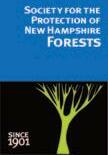
YES, I’D LIKE TO CONTRIBUTE TO THE DEREVYA FARMS PR OJECT TO CONSERVE 116 ACRES IN ALLENSTOWN! Name: Address: Telephone: Email: Enclosed is my tax-deductible contribution of $_____________ VISA MasterCard Number: ________________________________ Exp. date: ______ Security code: ______ Please mail the completed form to: Society for the Protection of New Hampshire Forests 54 Portsmouth Street, Concord, NH 03301 Or donate online at forestsociety.org/derevya. For more information, call Anne Truslow at 603-224-9945 or email atruslow@forestsociety.org. Thank you for your help! Town/City: State: Zip: 4104T123/DF22BFN Proposed Conservation Easement Derevya Farms 116 ± acres Allenstown, NH DowstRd WingRd New Rye Rd DeerfieldRd Nute Rd Philbrick Rd Birchwood Dr River Rd ChestnutDr Old Mountain Rd Clearview Dr Mountain Rd Highfield Dr KenwoodDr Nute Rd 00.8 0.4 Miles ^ Derevya Farms Conservation and Public Lands ± EPSOM ALLENSTOWN Derevya Farms, Proposed Conservation Easement, Allenstown, 116 Acres Bear Brook State Park, Allenstown, FO, DRED, 9076 Aces NRCS, WRP, Eames, Allenstown, CE, USDA NRCS, 86 Acres Harkness Easement, Epsom, CE, BPRG, 62 Acres LittleBearBrook (OPPOSITE PAGE) STACIE HERNANDEZ
54 Portsmouth Street
Concord, NH 03301-5400
Address Service Requested
THE MANY FACES OF CONSERVATION
Nonprofit Organization
US Postage Paid Manchester, NH
No. 0494
M E M BE RS MA KE
THE D I FF E R E N CE!
Roger and Linda are among the 10,000 members who help the Forest Society protect and manage critical lands for wildlife, water quality, wood, and wellness across the state. To join them, use the envelope in this issue, or visit forestsociety.org/join-today.
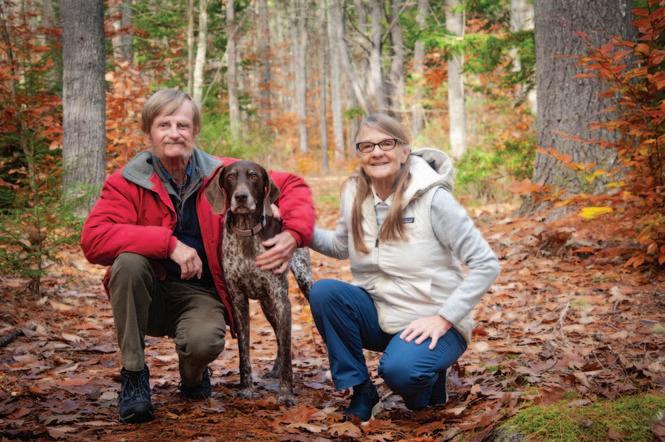
“Shortly after I moved to Wolfeboro permanently in 1969, I joined the Forest Society, which seemed to have been involved in every major New Hampshire environmental issue since the founding of the White Mountain National Forest in the early 1900s. It was important to me that the Forest Society had protected significant parcels of land that were open to the public and encouraged sustainable forestry. When I married Linda in 1979 and we moved to Wolfeboro, she also became a Forest Society member.
“We acquired a German shorthaired pointer who had enormous energy and required lots of exercise if we were to survive together. On our walks, he continually reminded me that the woods are a fascinating place and the walks reinforced my belief that, no matter what happened earlier in the day, the world just seemed a better place after a walk in woods.
“Between 1975 and 2005, we bought additional parcels of land around our house featuring brooks, beaver ponds, cellar holes, cemeteries, and hiking and cross-country skiing trails, which have
been a source of great enjoyment to me and Linda, our children, our grandchildren, and our dogs. As time passed, we realized we did not want the land to ever be developed. Given our long association with the Forest Society and our knowledge of their many accomplishments, we turned to them for assistance. Working with their excellent and knowledgeable staff, we placed a conservation easement on most of our land and donated the easement to the Forest Society this past August. With the Forest Society’s help, the land is now protected forever.”
Permit
SOCIET Y FOR THE PROTECTION OF NEW HAMPSHIRE FORESTS
PHOTO: AL KAREVY
Roger and Linda Murray with their dog Finley Wolfeboro, N.H. Members since 1973








































































